I was recently asked this question and I thought all our readers deserved a chance to chime in. Our 8-bay Xtreme Signal HDB8X antenna is a real superstar, picking up channels from up to 70 miles away. It’s one a very small number of antennas that can pivot in the middle, and that means the two sections can move enough to cover an area almost 180 degrees. If you took two of them, could you have a giant, monstrous omnidirectional antenna? Let’s talk it out.
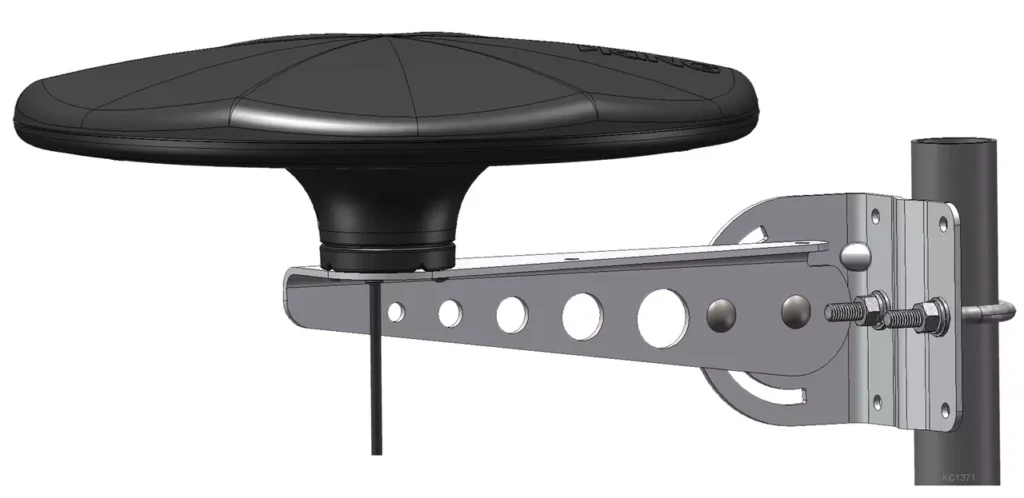
An omnidirectional antenna, or omni for short, uses a wide flat element to pick up signals from all directions at the same time. This technique isn’t really very efficient which is why this KING antenna can only claim 35 mile range even with an amplifier. Still, it’s the best choice for urban dwellers whose broadcast towers come from several directions. If you live between several cities, that 35-mile range isn’t going to do much for you.
That’s why most suburbanites want directional antennas. Directional antennas pick up all their signals from one direction (not the boy band). The signals they pick up must be pretty close, though. We use the term beam width to describe how far apart in compass headings two signals can be to have the antenna pick up both of them well.
The HDB8X antenna is really an array of two smaller antennas combined together. We know that that the each panel of the HDB8X has a beam width of 60 degrees. Bear with me here, this gets a little funky in the math department.
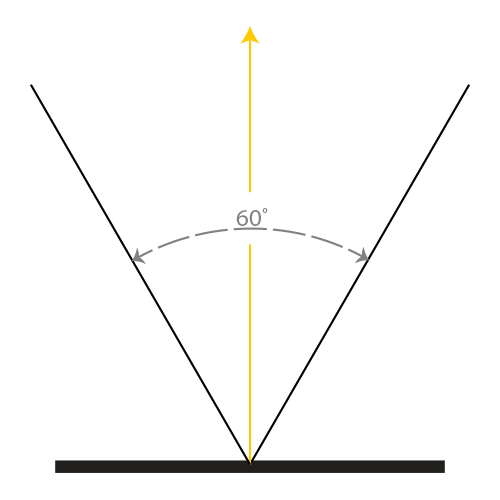
This is what one panel of the antenna looks like from the top. You can see it covers 60 degrees of sky. If we’re going to cover as much area as possible, we actually need to angle the two panels about 30 degrees apart so they look like this.
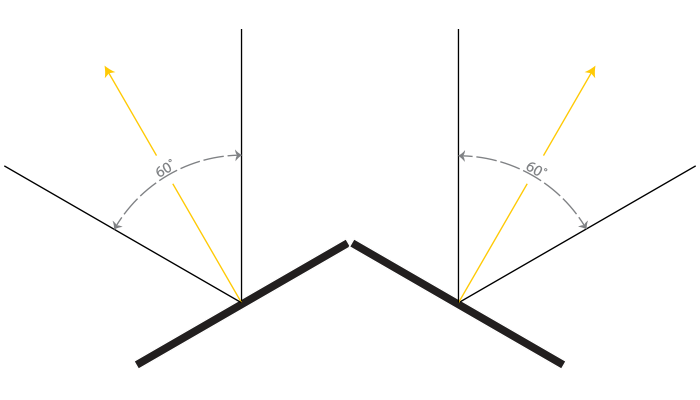
This covers 120 degrees of sky. In fact it covers a little less because there’s really not great coverage facing directly ahead. In reality you would end up angling the antennas a little bit toward each other to try to eliminate that.
If we wanted a gigantic omnidirectional antenna, we wouldn’t need four antennas, we’d need six, all aimed like this:
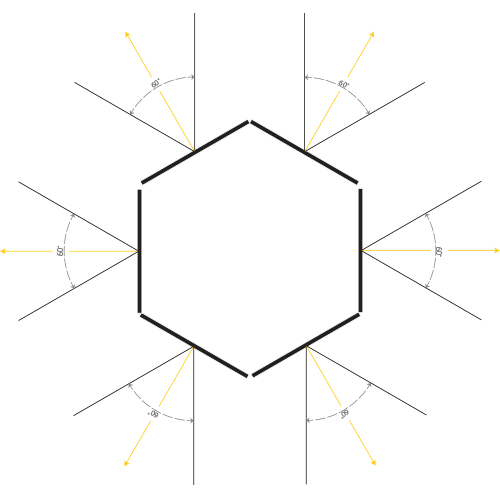
Now, at this point you’ve spent a lot of money and you still have six blind spots to deal with. If you really wanted to have true omnidirectional coverage you’d probably end up shoehorning another HDB8X antenna in so you could point the other six antenna panels slightly toward each other. You’d end up with something like this ungainly monstrosity:
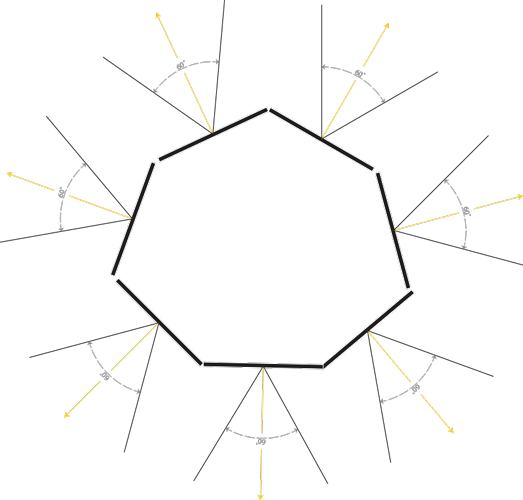
You’ve spent a lot of money at this point, will it all work?
By using an 8-way combiner, you could take all seven panels and combine them. You’d want to make sure the cables coming from all seven were exactly equal to eliminate all phasing issues. You would be receiving signals from all directions.
However, there’s something to consider. The insertion loss, the loss that you get from just combining signals, can be pretty high with an 8-way combiner. In a worst case scenario the insertion loss would be about 12dB with a traditional splitter/combiner. Considering the gain of each panel is only about 14dB maximum, you’re actually eliminating any benefit from the antenna.
You can use something called a “radial combiner” which will preserve a lot more of the signal but that can be very, very expensive. At this point you could be out of pocket over $2,000 on this project and it’s hard to know what the benefit would be.
The truth is you probably don’t really need 360 degree coverage of distances up to 70 miles. I’m sure some people do, but I would say very few. By combining between two and three long range antennas like our HDB91X or DATBOSS MIX LR, you can reach the specific locations you’ll need and not have to deal with as many problems.
If you’re interested in the best options for antenna combining, call us at 888-233-7563 or fill out the form below. We’re happy to help!
The post Can you make a giant omnidirectional antenna from two HDB8X antennas? appeared first on The Solid Signal Blog.
Continue reading...
The difference between omni and directional

An omnidirectional antenna, or omni for short, uses a wide flat element to pick up signals from all directions at the same time. This technique isn’t really very efficient which is why this KING antenna can only claim 35 mile range even with an amplifier. Still, it’s the best choice for urban dwellers whose broadcast towers come from several directions. If you live between several cities, that 35-mile range isn’t going to do much for you.
That’s why most suburbanites want directional antennas. Directional antennas pick up all their signals from one direction (not the boy band). The signals they pick up must be pretty close, though. We use the term beam width to describe how far apart in compass headings two signals can be to have the antenna pick up both of them well.
Looking at the HDB8X antenna
The HDB8X antenna is really an array of two smaller antennas combined together. We know that that the each panel of the HDB8X has a beam width of 60 degrees. Bear with me here, this gets a little funky in the math department.

This is what one panel of the antenna looks like from the top. You can see it covers 60 degrees of sky. If we’re going to cover as much area as possible, we actually need to angle the two panels about 30 degrees apart so they look like this.

This covers 120 degrees of sky. In fact it covers a little less because there’s really not great coverage facing directly ahead. In reality you would end up angling the antennas a little bit toward each other to try to eliminate that.
If we wanted a gigantic omnidirectional antenna, we wouldn’t need four antennas, we’d need six, all aimed like this:

Now, at this point you’ve spent a lot of money and you still have six blind spots to deal with. If you really wanted to have true omnidirectional coverage you’d probably end up shoehorning another HDB8X antenna in so you could point the other six antenna panels slightly toward each other. You’d end up with something like this ungainly monstrosity:

You’ve spent a lot of money at this point, will it all work?
In theory yes, but…
By using an 8-way combiner, you could take all seven panels and combine them. You’d want to make sure the cables coming from all seven were exactly equal to eliminate all phasing issues. You would be receiving signals from all directions.
However, there’s something to consider. The insertion loss, the loss that you get from just combining signals, can be pretty high with an 8-way combiner. In a worst case scenario the insertion loss would be about 12dB with a traditional splitter/combiner. Considering the gain of each panel is only about 14dB maximum, you’re actually eliminating any benefit from the antenna.
You can use something called a “radial combiner” which will preserve a lot more of the signal but that can be very, very expensive. At this point you could be out of pocket over $2,000 on this project and it’s hard to know what the benefit would be.
A better option
The truth is you probably don’t really need 360 degree coverage of distances up to 70 miles. I’m sure some people do, but I would say very few. By combining between two and three long range antennas like our HDB91X or DATBOSS MIX LR, you can reach the specific locations you’ll need and not have to deal with as many problems.
If you’re interested in the best options for antenna combining, call us at 888-233-7563 or fill out the form below. We’re happy to help!
The post Can you make a giant omnidirectional antenna from two HDB8X antennas? appeared first on The Solid Signal Blog.
Continue reading...

